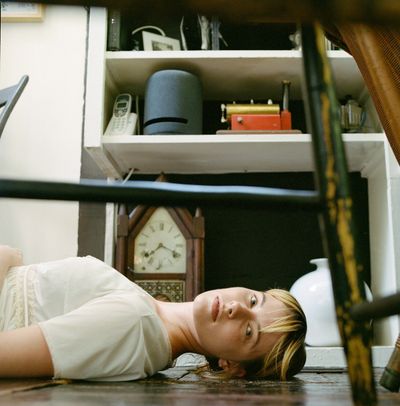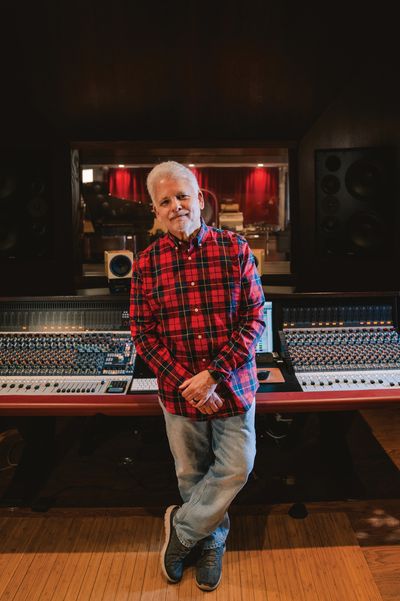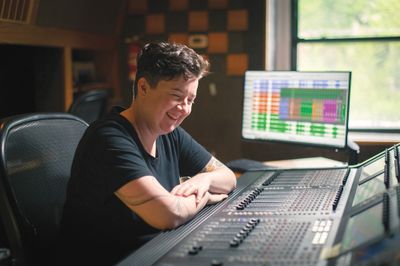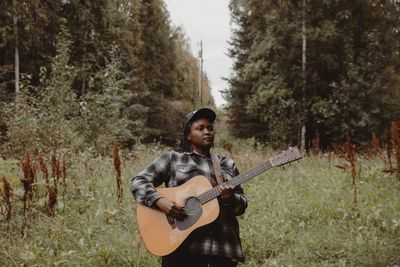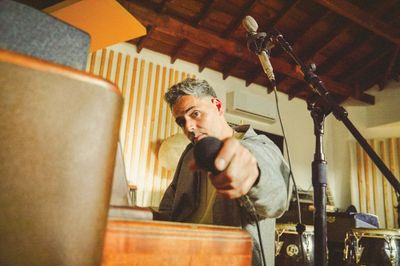Can you tell me about the origins of this project?
I used to work as a recording engineer at The Hit Factory in New York City in the mid-to-late '90s. I was on my way to work one day, and I was in a subway station. As you know, there's music playing in the subway every day; but on this one day, the platform was packed with people. I looked around to see what it was, and I saw two monks, painted all in white, with robes on. One was playing a nylon [string] guitar, and the other one was singing in a language I didn't understand. Everyone was packed in; I saw people with tears in their eyes, smiling and laughing. As I got on the train and went to work in the studio, it occurred to me that some of the best music I've heard in my life was on the way to the studio, not in the studio! That was the day I realized great music and great art are moments in time. They exist everywhere and, with recording equipment technology, we can harness those moments. That was the birth of Playing for Change, [as well as the inspiration] to travel to natural environments — subways, street corners, Indian reservations, African villages, Himalayan mountains — wherever people are playing live, outside in natural environments. I wanted those moments.
What were you working with, initially?
I decided to try to simulate the high quality of a good recording studio, in the street. I put together a setup powered with golf cart batteries, and eventually car batteries. First it was domestic — recording in city streets across the U.S. and on Indian reservations. I started out with a pretty good rig — I had a Grace Design m801 preamp into an 8-channel Apogee converter. Later I switched to portable, battery pack-powered Grace mic pres and a Pro Tools system. For a while, it was Pro Tools LE with six inputs; two digital and four analog. The other important things were the microphones. When I was recording with Paul Simon in the studio, we were using Schoeps microphones. We got a pair of CMC 6 Ug matched Schoeps mic bodies that have different capsules 12 years ago, and we've used them ever since, on almost all of the recordings. So, a lot of it was born from a New York City studio and evolved into something that we could take to the street.
Did you have any experience with location recording when you started?
I had recorded music, but not outside. The first couple of years [touring] across America was the experiment. By the time I started going around the world, I'd already recorded many musicians across America. The first video was "Stand by Me" and, if you listen to the new stuff, I think there's a dramatic improvement in the sound and the video quality. But I think, from the beginning, we started getting high-end recordings in the field, and that was the point. It has gotten better since then.
One could also argue that fidelity is not the point of a project like this.
With a lot of music documentaries, whenever you would hear street musicians it was always some camera mic picking them up. I always felt like they never got a fair shake. We realized if we brought good microphones, used different windscreens, a nice clock, good mic pres, and recorded it at a higher quality, we could give these things a chance to actually be represented properly to an audience. So, that's why we wanted to bring the studio to the street, instead of using camera mics.
How did you pick the recording gear?
There's a guy named Mickey Houlihan, and he's been our audio wizard. He's helped us set up stuff from the very beginning of the project. He's friends with Michael Grace, who makes the Grace mic pres. Grace Design have been very supportive of the project, and they get what we're doing. Their Lunatec stereo mic pre has a built-in clock, and they're great-sounding mic pres. They make a specific rechargeable battery pack that can power them. We never have to plug anything in when we're out in the field. The most exciting thing about this project is the ongoing learning process. You learn how to put the microphone furthest from the loudest thing, as well as what it takes to get an inspired performance. If it feels good, it'll sound good. The project's built on the fact that these people are so comfortable. They're outside, doing what they do.
What other pieces of gear do you consider essential?
A couple of dynamic mics — [Shure SM]57s, a mic for a drummer with low-end percussion, or for upright bass. Oh, and headphones! That's all the gear that I need to do it. I bring all different kinds of mics and spend time with the placement and stuff, but for the most part it's an organic thing.
What would you not bring along, because of the hassle?
In the beginning I bought a nice DPA mic, one of those high-voltage mics that's got a line output. It was so overwhelming; you could hear cars two miles away. Nicer condenser mics that have any kind of wide- spectrum are a nightmare for us. We try to pinpoint everything and combine it with some DIs — then you can get a good track. But I've got to say — the best- sounding drums that I've ever recorded have been outside. There's something about the decay of nature that is unbelievable!
In a sense, you're probably doing much more outlandish things with the acoustic environment than anybody who's working in a studio.
They happen naturally, because you're not really controlling it. You're going along with it. So the birds are usually in tune and in time — it all seems to work out. As soon as the musicians hear it in their headphones, they feel so good. They feel like they're in a recording studio, but they're sitting on a park bench in a village, or in a ghetto in Brazil, playing congas outside.
When you're looking at mics you might use, are you generally looking for something that's as tight as possible, to minimize all the ambient noise that you run into?
Yeah, I definitely want them as tight as possible. You've got to figure that, for the songs we make, there are anywhere from 30 to 80 musicians on the track. By the time we're done, we've got all that accumulated noise, but we also have all that accumulated energy. We have to be careful about keeping out sounds, like rumble and high-end squeaks of brakes on cars. That stuff can be a drag.
How bulky is the setup?
With my backpack and a carry-on, I can carry all my audio hardware, software, the microphones, and everything like that. I have a checked bag that's very heavy and long with wheels on it. That's got all the mic cables, mic stands, and DIs; items I'm willing to check-in at the airport. We also have a bag of cameras. Now we use these new Canon cameras, like the EOS 5D and the 7D; they're much smaller, but such higher quality. You can get this cool film look with the depth-of-field, and that's helped us.
You check this gear when you're traveling? Have you run into any trouble with that?
We try to carry-on all the expensive stuff and only check the heavy, miscellaneous things. I would say that we've run into trouble at almost every airport in every third-world country — the sheer fright on their faces when I drop one of my bags on their scale. We went to film in Cairo after the bombing of the Israeli embassy, and it was a tight situation. They actually tried to take our cameras and some of our audio gear from us. Fortunately we were able to let them hold on to one of our cameras that actually wasn't working, and that gave us a chance to get through. Just making sure that none of it gets stolen, monitoring all of it, is tense. But, at the same time, karma is on our side, you know? This is a fun project that gets people excited. We have the will to make it work, and the gear always makes it with us. In the beginning we had stuff stolen on our first couple of trips outside of America — cameras and microphones. Since then, nothing's happened. We've been careful, and I guess also fortunate.
Do you usually bring multiple rigs with you, or is it all tied into the same setup?
I bring extra Grace mic pres, just in case. My music producing partner, Enzo Buono (he has produced all the music with me from the beginning of Playing for Change), also carries a backup of whatever our interface is going to be. Right now, it's the M-Audio ProFire 610. We each carry one of those. He's got Pro Tools on his laptop and I've got it on mine.
Do you have any custom gear?
I did have the Grace 801 modded so it wouldn't be stepped, and so we could move the gain up, or down, without it making a sound. Those mic pres make a click if you do it live, so they set it up for me. But, to be honest, I haven't used those in a long time. Now I use the Lunatec, and it's already got that feature. Some of the power supplies are custom. First we had a custom inverter for the golf cart battery, and then we had a bunch of different battery packs made for the Grace. They last a long time — I can easily get five hours of recording. The only thing I have to do in the meantime is deal with the laptop, so we always show up with two charged laptops. On the old Mac laptops you could bring extra battery packs and that was awesome; but the new ones don't have that, so we bring two charged Macs and that's as long as we've got. It's probably two or two and a half hours.
Do you still find yourself cleaning up background noise?
Greg Morgenstein is one of the guys who mixes some of the Playing for Change songs . He's a great mixer in L.A., and he's been incredible. He's done our audio cleanup since the very beginning. Technology has evolved a lot for him; he can go in and remove sounds that we need to get removed. I've heard him take cell phones out of a performance; it's incredible! If there's a problem, we try to solve it, because there's no way of going back into Nepal to record.
I know you have recorded some fairly high-profile musicians, such as Bono and Keith Richards, recently.
Well, Keith and Bono are two different examples. Keith's session was exactly what we normally do. Outside, on an island, by the water with the waves — just Keith Richards. He did such an unbelievable performance. He had a nice Martin guitar and was playing his ass off; but he just used our rig, right there! For Bono, we actually recorded him inside, at the U2 studio in Ireland, so he used his own rig and then we plugged into the output of his chain.
Have there been many experiences like that?
Not really. For the most part it's usually just us. Taj Mahal, Keb' Mo', Los Lobos, Sandra de Sá, Manu Chao, and Carlos Vives — all those musicians let us use our own gear. They're all so happy when they hear it because it's such a great vibe. They're excited try something outside. Taj was in Central Park, Keb' Mo' was on back porches, and Manu Chao was under an archway in Barcelona, Spain. There's great reverb on his guitar, and his voice from natural reflections.
What issues do you run into, in terms of tuning and keeping people on the click?
Maybe half the songs are to a click, and half aren't. Sometimes we do a click for a certain reason, too. We've made songs around the world, but then we wanted to evolve it. On the last album we had one track we worked out with the Marley family, and one track with the John Lennon estate. We got to do "Redemption Song" and "Imagine." We got to use a multitrack recording on each one, — Bob Marley's acoustic guitar and voice, and John Lennon's vocal and piano — with the rest of the world. We needed to set a metronome around that part of the performance for those tracks. We use a click when it's best, just like in the studio. Sometimes it's better to be free in the moment and let the music be what it is. We recorded an orchestra of kids in Columbia; they were all orphaned from the war. They were so incredible. We worked with them to tune up and took our time. We definitely bring a tuner with us everywhere we go and tune everything. If you get a great performance and it's out of tune, it doesn't work unless it's a vocal, or a bass, that needs to be tuned a little bit. You can tune anything these days with [Celemony's] Melodyne!
Are language barriers a problem?
Sometimes I speak one language, they speak another, and there's somebody in the middle translating between us. Sometimes there are two guys in the band that speak different languages — there could be multiple languages leading to one getting translated! We first try to listen to what they do, and then often we ask them to play half as much, which doesn't take too much translation. A lot of times people get excited; we need them to be able to listen to everybody else to find the best groove and melody.
How do you feel about moving people from the initial locations where you find them? Will you take them around the corner to try to make the soundstage a little bit cleaner?
We try to respect each situation. If we show up on location and people are already performing with an audience, we're not going to move them. If where they're playing doesn't work at all with what we're doing, like there's a lot of wind, too many people, or the police won't let us film, then we'll scout [locations]. We'll listen and arrange another time with the musicians. But a lot of times it's very spontaneous. There's not a lot of scouting out places to record. For the most part, it's scouting for the musicians.
How do you approach paying the musicians?
I think the general idea is to make it a great experience for every musician we meet. How you deal with money in each part of the world is based on their economy. We usually talk to other musicians and our guide about what would be an appropriate amount of money to pay these musicians for the amount of time that we're recording them. Then, at the same time, we're taking all of their information. We're paying the performers that are involved; we're also offering artist royalties for featured performers, which tends to generally be someone who started the song, different lead singers, and soloists. There ends up being so many other musicians that there's no other way for it to have any real kind of value. So we have featured artists take their royalties, and all the individual artists get paid based on an economy of scale with the intention of rounding it up. It's a great experience for everybody.
Can you tell me about some of the weirdest physical spaces you've ever had to set up in?
Sometimes, it's as simple as j a completely barren place in the middle of a desert, like in northern Africa, New Mexico, or up in the Himalayan Mountains. Well, the Himalayan Mountains were different; there you've got a bed of cicadas everywhere and you're essentially recording in a forest. There are a million little background noises that all blend together to make this incredible bed. In the desert it's crazy, because it can be so hot and there's not even a single tree. In Mali, Africa, we've recorded on mountaintops. In Brazil we've recorded in the favelas [shanty towns]; that's crazy, because you're recording between these tiny houses all on a hill. Recording in a lot of city squares is cool, especially in Colombia, Brazil, Mexico, and through South America. There are a lot of different squares that have this great reverberation.
What about some of the technical difficulties you've run into along the way?
Our biggest concern all the time is, "When will the batteries run out?" There is no wall to plug into, there's no plan B. I think some of the toughest technical environments are a combination of wind and car noises. Simply turning people around [helps]. You can have people in the same exact location and have them turn the opposite direction.
Is there a lot of rehearsing with the musicians before you do the recording? That would save even more battery time.
I remember when I used to work for Jackson Browne. He said to me, "Sometimes the best music in the world is right before you learn it." We decided to record and film every rehearsal, because often the featured performance ends up being the first take. Maybe it's the last one, or maybe it's the first of a direction we're going to go in, but it's not like we can sit out in the field and record many takes of anything. We sculpt it pretty quickly with the artists.
Are there cases when the cow is mooing in the background, and that had to be the take?
Of course! Sometimes it's because it's the only take, so we'll end up with people talking in the background or a car horn. In certain cases, it can be animals making noises. Over time we've managed to cut down on the outside noise. We make it part of the music because if you're there, that's what you're hearing. Including nature in the recordings and making that a part of it is one of the coolest aspects, to me. Sometimes I can hear monks chanting on certain tracks we've recorded, where we weren't recording monks! Or again, beds of cicadas that made it sound like Pink Floyd.
Are there certain parts of the world that have proven too problematic?
No, because I think we look at it more like each obstacle is an opportunity. It's not a political project; but life is political, so they do overlap. On a recent trip to Cairo, Egypt, we ran into the political climate. We're trying to unite cultures that are politically divided, so we're using music to try to transcend very deep differences, misunderstandings, and conflicts. That brings a whole other element of difficulty in uniting musicians. It's not so easy to go to Israel, or go to the Middle East, or an Arab country and unite them through song. Sometimes there's some danger around it. When we first started, we went down to South Africa and started traveling throughout the townships. We recorded in Soweto, the murder capital of the world, and you always attract a crowd. In the beginning it was complicated to tell who were the gangsters and who were the musicians. What was the environment of white people coming into these ghettos, recording music and trying to film something, and not exploit anybody? We would use whatever technology we had at the time to show people what we were doing — back then it was an iPod video. I could show different people some of the songs we were working on, whether they were musicians or people looking at us wondering what we were doing. At one point we had these guys look at us; they watched one of our videos and they walked away smiling. Their friend said, "Just so you know, those were the gangsters. Normally they would have killed you, robbed you, or taken your stuff. But instead they see what you're doing, and they told us they've got your back while you're here — you're safe."
